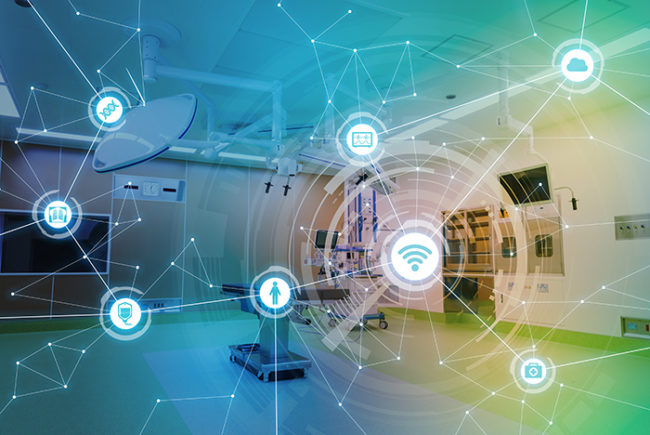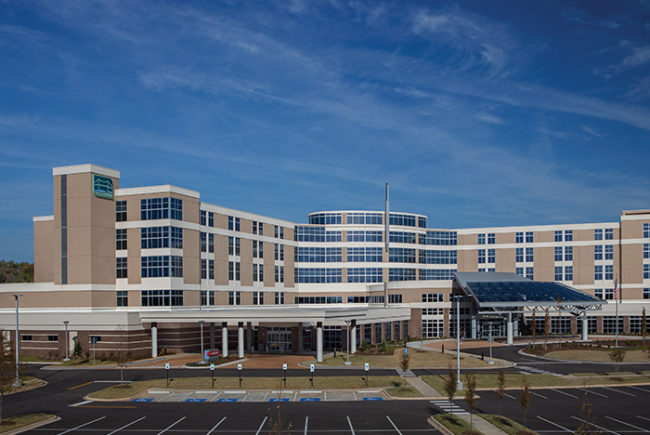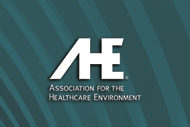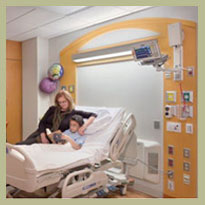 Today’s health care administrators face a new delivery model driven by outcomes-based care and reimbursement rates tied to patient satisfaction and compliance. Now, more than ever, operational efficiencies on the clinical and facility sides are critical to success.
Today’s health care administrators face a new delivery model driven by outcomes-based care and reimbursement rates tied to patient satisfaction and compliance. Now, more than ever, operational efficiencies on the clinical and facility sides are critical to success.
As more organizations recognize the building as an instrument of care, they are using innovative strategies to integrate disparate building, business and clinical systems to reduce cost while providing better care. The results push the boundaries of what’s possible.
Case 1: Roy and Patricia Disney Family Cancer Center
Opened in February 2010, the Disney Family Cancer Center, Burbank, Calif., provides diagnosis, treatment, professional counseling, support groups, pharmacy and educational resources in one 55,000-square-foot location. Its holistic design is intended to create a peaceful sanctuary for cancer patients, incorporating art, therapeutic music and soothing colors, supported by innovative planning and the design of the enabling information technology (IT) and building infrastructure.
Planning for the center began long before its construction. The project team recognized that the architectural design and comprehensive clinical offerings needed to be complemented with integrated, future-ready technologies that would help accomplish a variety of goals. The goals include reducing patient anxiety while receiving treatment and improving workflow between clinicians, patients and administrators.
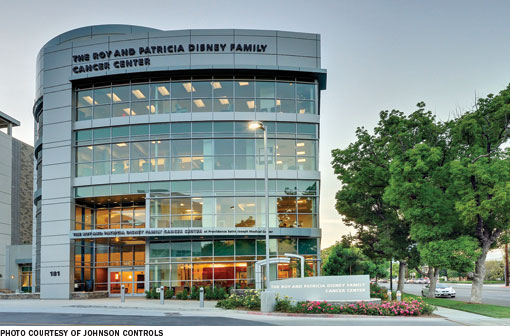 |
|---|
| The Disney Family Cancer Center uses one IT backbone for disparate systems. |
The Disney Family Cancer Center worked with a building technologies company to assess its technology needs and design one IT backbone — rather than multiple networks — that can be used by all the building automation, security, clinical and administrative systems to reduce unnecessary duplication and infrastructure costs.
For patients, the Disney Family Cancer Center is an experience rarely seen in health care. By leveraging the capabilities of a security management system and integrating real-time locating systems (RTLS) and integrated clinical systems, the building interacts with the patient. When patients first visit the center they are enrolled in the system’s database and can select preferences for treatment rooms, including lighting, temperature, music and video imagery that create a personalized experience.
Then, through the use of RTLS badges issued to patients, the building, business and clinical systems stay two steps ahead of a patient upon their return. Because the system is integrated with a building management system, HVAC and lighting settings in the room are automatically adjusted to the patient’s preference as he or she arrives for treatment.
Nearly 20 different systems were integrated to provide authorized staff with access to real-time monitoring and controls data so they can make adjustments accordingly. For the Disney Family Cancer Center, the integration of building systems positively impacts patients while reducing infrastructure costs, increasing operational efficiency and improving workflow. This translates to increased medical efficiencies and enhanced patient comfort for years to come.
Case 2: Methodist Le Bonheur Healthcare
Methodist Le Bonheur Healthcare in Memphis, Tenn., is committed to providing high-quality, cost-effective health care to the communities it serves. With seven hospitals, multiple home health agencies and outpatient clinics to serve the mid-South, Methodist is one of the largest health care organizations in the country.
Methodist turned to a planning and consulting service to facilitate discussion and planning sessions among key stakeholders. These discussions enabled the group to define sustainability for their organization. For Methodist, it means having a triple bottom line: building green, saving green and living green.
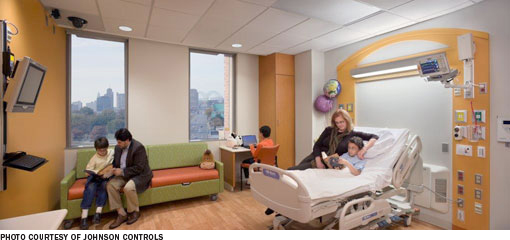 |
|---|
| A patient room in Le Bonheur Children's Hospital. |
The first green new construction took shape in the new Le Bonheur Children’s Hospital. The $340 million, 610,000-square-foot Le Bonheur Children’s Hospital with 12 patient floors and 255 beds significantly increases Le Bonheur’s space for patient care, research and training. The building technologies company is serving as the Leadership in Energy and Environmental Design (LEED) accredited professional that provides tools and guidance to help Le Bonheur Children’s achieve LEED certification.
The hospital’s new technology systems include a converged IT network that supports clinical, facility and business services. The planning process also helped identify the most appropriate technologies and the best way to leverage them. For example, the fully integrated operating rooms provide advanced options for surgeons and staff. From a central touchscreen station in each operating room, the staff is able to adjust temperature and lighting.
Cameras are able to record each surgery and map it to a conference room, giving physicians in training an opportunity to observe. The converged IT network can adapt to the hospital’s changing technology for years to come.
A key contributor to Le Bonheur’s LEED certification and cost-effective construction is a modular central plant comprised of 13 modules. The plant is one of the largest modular facilities in the United States to include boilers, chillers and generators. The plant’s heating; cooling and electrical systems are designed to run at maximum efficiency, which reduces the hospital’s carbon footprint.
By leveraging technologies and best business practices, Methodist can improve patient safety, reduce Occupational Safety & Health Administration-recordable incidents, improve associate satisfaction and productivity and assess risk and prioritize capital spending.
Case 3: DuBois Regional Medical Center
DuBois Regional Medical Center (DRMC), DuBois, Pa., widely recognized as one of the leading health centers in Pennsylvania, is an oasis of clinical and technical excellence with a focus on patient-centered care. The regional medical center is comprised of three hospitals and a medical arts facility on two campuses where more than 1,700 staff, physicians and surgeons provide comprehensive healthcare services.
In a progressive effort to better leverage existing and new clinical systems, operate more efficiently and improve clinical workflow, DRMC chose a building technologies company to deploy a secure and robust IT infrastructure comprised of both wired and wireless data network systems.
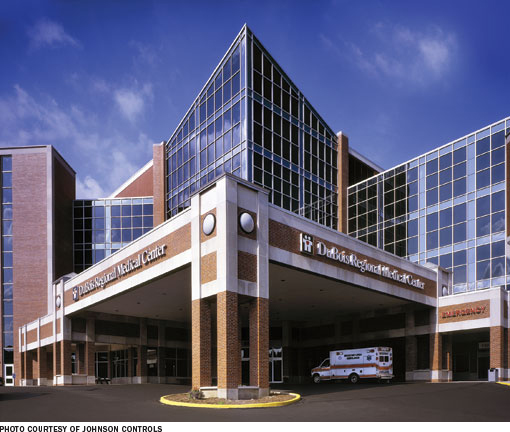 |
|---|
| DuBois Regional Medical Center's infrastructure has wired and wireless systems. |
The new network is the first step toward the ultimate goal of transforming DRMC’s IT infrastructure, communications methodology and clinical workflow to a fully converged and integrated platform.
DRMC has achieved certified meaningful use of its electronic health records (EHR) systems, which run on the network. This accomplishment is well ahead of the 2015 federal deadline and made DRMC eligible for Medicare and Medicaid EHR incentive programs.
Innovations in the clinical information environment allow for considerably more efficient operation of facilities with maximized profitability and return on investment. More importantly, fully converged and integrated facilities will enable DRMC to leverage investments in new clinical systems and existing ones, which will have a direct positive impact on the quality of patient care
A medical-grade local area and wireless network was designed to support data and voice services for DRMC, both now and in the future. The network provides coverage to patient rooms and clinical, work, public and storage areas, along with stairwells, elevators and mechanical rooms at each facility.
The new robust network incorporates power over ethernet (PoE) technology and a virtual switching system (VSS). PoE technology provides added flexibility for using wireless devices that would otherwise need an external power supply. The VSS delivers a superior level of redundancy ensuring non-stop patient and business data communications, which didn’t exist previously. For DRMC, this is especially important because its mission critical servers are cloud-based. VSS also serves as a single point of control for wireless at all sites.
The network also supports numerous technologies such as telemetry, real-time location services, nurse call and voice over Internet Protocol, to name just a few, providing DRMC a platform for future health care technology integrations.
Forward-looking facilities
These three forward-looking healthcare facilities are planning to meet the challenges they will face in the years to come by developing an expandable technology base today. Their use of single IT networks is allowing them to integrate systems to provide higher level of services throughout the entire patient-care process. The results include operational efficiencies, improved business practices, environment protections and higher satisfaction levels for clinicians, staff and patients.
Brendon Buckley is health care technology systems manager, North America, for Milwaukee-based Johnson Controls. He can be reached at Brendon.f.buckley@jci.com.



